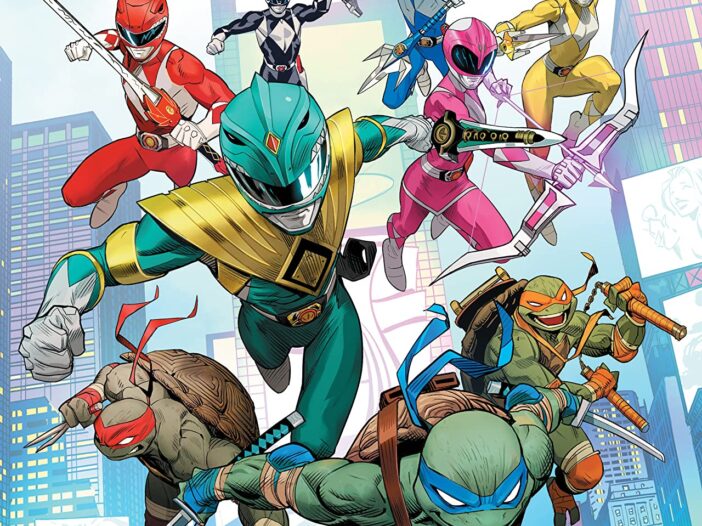
Review: Mighty Morphin Power Rangers/Teenage Mutant Ninja Turtles

Mighty Morphin Power Rangers/Teenage Mutant Ninja Turtles
Writer: Ryan Parrott
Artists: Simone Di Meo, Alessio Zonno, Walter Baiamonte and Igor Monti
BOOM! Studios; $19.99
The Teenage Mutant Ninja Turtles and Mighty Morphin Power Rangers mass media franchises actually have quite a bit in common, despite the vast differences in their starting points. The former began as a self-published black-and-white comic book parodying various trends of 1980s super-comics, of course, while the latter began as a live-action children’s superhero show based around stock footage from a Japanese television series.
When the Turtles got their second life as cartoon stars hawking a toy line in 1987, though, the similarities became more apparent: Both franchises revolved around groups of color-coded teenaged martial artists with one assigned personality trait apiece, and both concepts steadily conquered every conceivable form of media and merchandising in the United States and around the world. The two franchises even briefly combined in 1998, when the short-lived live-action Ninja Turtles: The Next Mutation show crossed over with Power Rangers In Space.
ADVERTISEMENT
ADVERTISEMENT
It is therefore no surprise to see another crossover then, this time in the Turtles’ home media of comics. Never long absent from comics racks, the Turtles have been appearing in a series from IDW Publishing since 2011, while the Power Rangers returned to comics in 2016, this time at BOOM! Studios.
Refreshingly though, writer Ryan Parrott doesn’t get bogged down in the ongoing storylines of either of those books, nor does he seem concerned with it at all. Rather, he has constructed this five-issue miniseries-turned-graphic novel as a more-or-less standalone affair. Sure, you need to have at least a baseline familiarity with both franchises, a familiarity that anyone the least bit interested in the book would likely already have (or at least be able to learn by watching the opening theme songs of the original Turtles cartoon and the first season of Power Rangers).
Parrot and company basically produce their own versions of each of the two franchises and then begin mixing them together. The specific version of the Turtles is basically that of the original cartoon series, but a bit more influenced by the comics and subsequent iterations. The Power Rangers are essentially those of their first TV show. But in both cases, they are portrayed in a more sophisticated, less childish way. Which isn’t to say the book is geared towards adults, it just doesn’t badly pander to kids in the way the TV shows did.
Green Power Ranger Tommy has gone missing from the Rangers’ home of Angel Grove, California, showing up in a rather unlikely place: Dressed in the uniform of a Foot Clan ninja in New York City, where he’s fighting the Teenage Mutant Ninja Turtles. The reason? He’s trying to infiltrate the clan in order to rescue an old friend of his, and he didn’t want to involve his new friends.
Things spiral out of control, however, when Tommy calls upon his super-powers to help him fight off the Turtles. This draws the attention of the other rangers, who show up to rescue their missing teammate and, well, comic book crossover rules apply: The heroes fight one another before realizing it’s all just a big misunderstanding and they are actually on the same side.
The real villain is, of course, The Shredder, who steals Tommy’s “morphin” abilities and stops the other Rangers from accessing theirs, ultimately allying himself with Rita Repulsa and combining their forces of bumbling, monstrous henchmen to launch an all-out attack on the heroes.
Parrott and company take advantage of the opportunity to do all of the mixing-and-matching the event allows for, like temporarily giving April O’Neil and the Turtles the Rangers’ powers and costumes, outfitting the Rangers as ninjas, and turning a Turtle robot into a giant robot capable of trading blows with giant-sized monsters and Shredder’s commandeered giant robot dragon.
ADVERTISEMENT
ADVERTISEMENT
Additionally, the book allows for plenty of comparing and contrasting of the natures of each team: The flashier, public superhero-style Rangers and the shadowy, unknown ninja Turtles who never get recognition for their deeds.
Di Meo’s artwork, colored by Walter Baiamonte (and this is one comic where color is pretty essential), sticks quite faithfully to the Power Rangers’ designs from the TV show, although the monsters and vehicles are all infinitely less clunky than the suits and special effects of an imported children’s television show. As for the Turtles characters, though, Di Meo basically invents his own versions, which are a compromise between the cartoon versions and the modern comics versions.
The art is highly detailed and features a thin line, with much of the action seemingly defying gravity; almost all of the fighting and ninja moves involve figures suspended in the air, as if flinging themselves through space.
Decades after the two franchises took up a seemingly permanent place in global pop culture, they continue to reinvent themselves and find new spaces to occupy. By joining forces, they’ve added the inter-company comic book crossover to their lists of accomplishments. Luckily for readers, its not just an exercise in box-ticking: It’s a very solidly produced, very fun comic book series.
Filed under: Graphic Novels, Reviews
About J. Caleb Mozzocco
J. Caleb Mozzocco is a way-too-busy freelance writer who has written about comics for online and print venues for a rather long time now. He currently contributes to Comic Book Resources' Robot 6 blog and ComicsAlliance, and maintains his own daily-ish blog at EveryDayIsLikeWednesday.blogspot.com. He lives in northeast Ohio, where he works as a circulation clerk at a public library by day.
ADVERTISEMENT
ADVERTISEMENT
SLJ Blog Network
At Last! Mr. Schu on The Yarn Podcast
Fuse 8 n’ Kate: Ginger Bear by Mini Grey
Parsing Religion in Public Schools
5 Middle Grade Books to Celebrate Planet Earth, a guest post by Kristin L. Gray
ADVERTISEMENT







